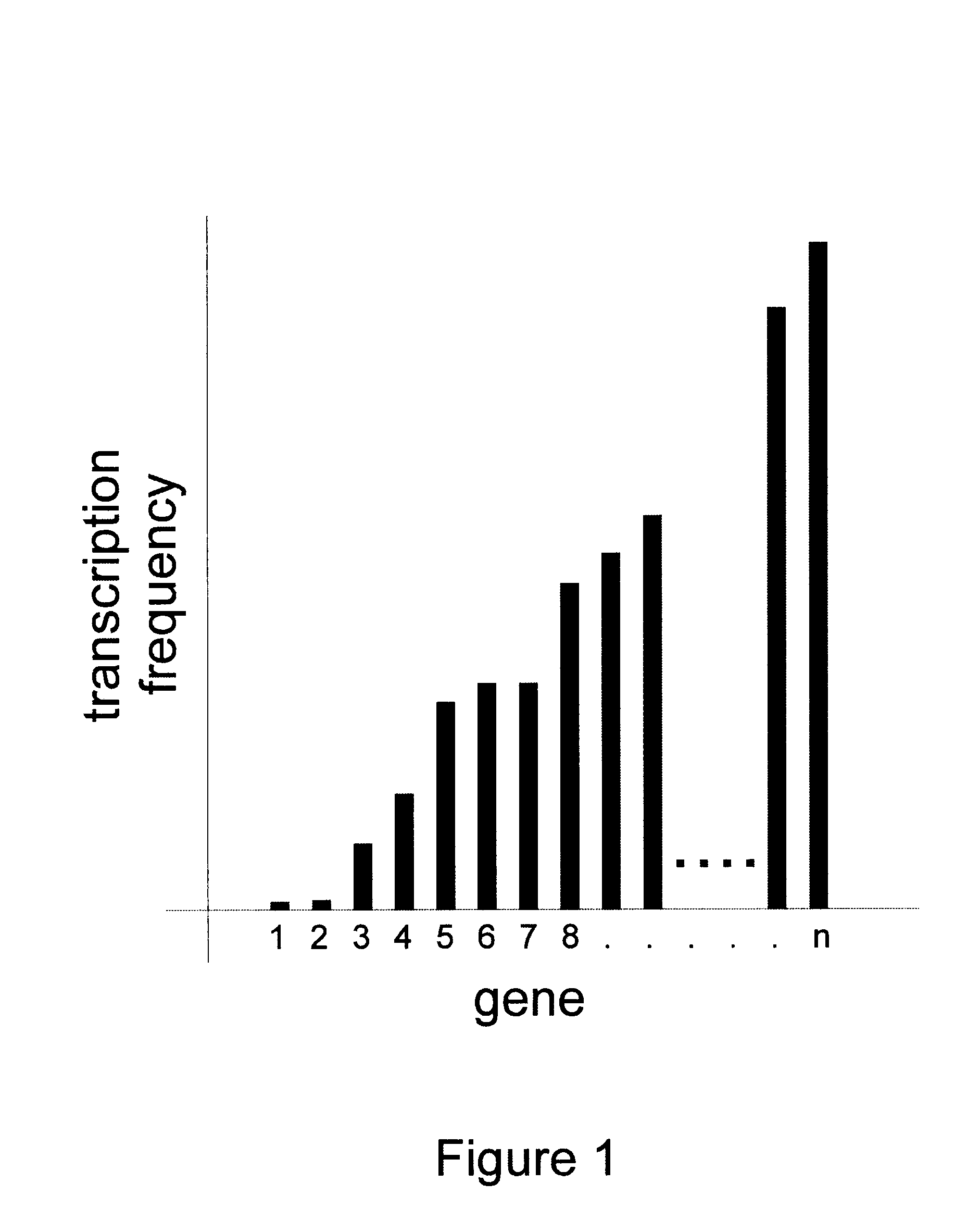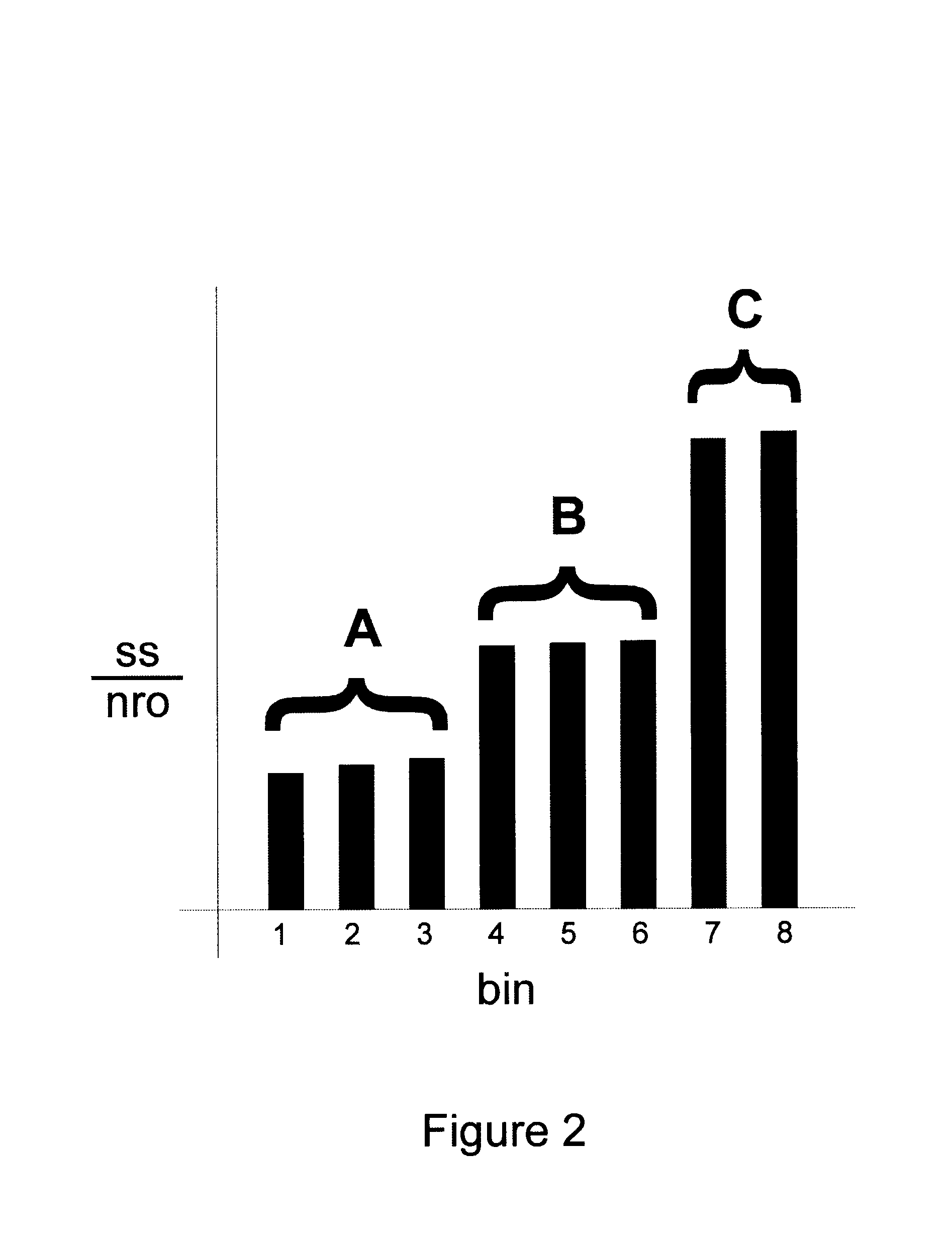Methods for gene array analysis of nuclear runoff transcripts
a gene array and transcript technology, applied in the field of gene array analysis of nuclear runoff transcripts, can solve the problems of limited number of genes that can be monitored, poor prediction of transcription rate of steady state mrna levels, and inability to accurately predict transcription rate of post-transcriptional processes, etc., to achieve rapid, efficient and extensive analysis of rna transcription rate
- Summary
- Abstract
- Description
- Claims
- Application Information
AI Technical Summary
Benefits of technology
Problems solved by technology
Method used
Image
Examples
example 2
This example illustrates nuclear runoff transcription following procedures described by Greenberg et al. in Current Protocols on Molecular Biology, supra. A sample of 10.sup.7 nuclei (.about.2 microgram of DNA by diphenylamine analysis) is used in each nuclear run-on experiment. The nuclei, 200 microliters of Reaction Buffer, and 100 microCi, 760 Ci / mmol .alpha..sup.32 P-dUTP are added to a polypropylene centrifuge tube and incubated for 30 minutes at 30.degree. C. with shaking to produce a solution of nuclei containing labeled transcripts. 0.6 ml of the DNase solution is added to the labeled nuclei, well mixed and incubated for 5 minutes at 30.degree. C.
A mixture of 200 microliters of SDS / Tris Buffer and 10 microliters of 20 mg / ml proteinase K is added and incubated for 30 minutes at 42.degree. C. to provide a solution containing labeled RNA.
example 3
This example illustrates the extraction and precipitation of RNA following procedures described by Greenberg et al. in Current Protocols on Molecular Biology (1997) Unit 4.10, incorporated herein by reference. The RNA-containing solution prepared in Example 2 is extracted in 1 ml of Extraction Solution and centrifuged at 2000 rpm for 5 minutes at room temperature. The aqueous phase is separated and mixed with 2 ml water, 3 ml 10% TCA / 60 mM sodium pyrophosphate and 10 microliter of 10 mg / ml E. coli tRNA, and then incubated for 30 minutes on ice. The TCA precipitate is filtered on 0.45 micrometer Millipore.TM. HA paper and washed three times with 10 ml of 5% TCA / 30 mM sodium pyrophosphate. The filter is incubated with 1.5 ml of DNase I Buffer and 37.5 microliters of 1 mg / ml RNase-free DNase I for 30 minutes at 37.degree. C. The reaction is stopped by adding 45 microliters of 0.5 M EDTA and 68 microliters of 20% SDS. The sample is heated for 10 minutes to 65.degree. C. to elute RNA. Th...
example 4
This example illustrates the hybridization of RNA to cDNA. A microarray comprising cDNA is prepared by attaching polynucleotides representing about 6,000 genes of Arabidopsis thaliana to defined areas on the surface of a negatively-charged, nylon support membrane. The polynucleotides are amplified cDNA molecules in the range of about 200 to 2000 nucleotide bases in length. The processed RNA solution prepared in Example 3 is mixed with 2.5 ml of TES / NaCl solution and allowed to hybridize to a microarray in a 50 ml chamber rotating at 65.degree. C. in a hybridization oven. The RNA solution is rinsed off the microarray by two 1 hour washings with 2.times.SSC at 65.degree. C. The microarray is incubated for 30 minutes in an RNase solution, rinsed again for 1 hour in 2.times.SSC at 37.degree. C., dried and placed in contact with a Fuji Phosphoimager.TM. imaging screen. After an appropriate exposure time the array image is read as a digital file representing the hybridization intensity fr...
PUM
| Property | Measurement | Unit |
|---|---|---|
| pH | aaaaa | aaaaa |
| pH | aaaaa | aaaaa |
| pH | aaaaa | aaaaa |
Abstract
Description
Claims
Application Information
 Login to View More
Login to View More - R&D
- Intellectual Property
- Life Sciences
- Materials
- Tech Scout
- Unparalleled Data Quality
- Higher Quality Content
- 60% Fewer Hallucinations
Browse by: Latest US Patents, China's latest patents, Technical Efficacy Thesaurus, Application Domain, Technology Topic, Popular Technical Reports.
© 2025 PatSnap. All rights reserved.Legal|Privacy policy|Modern Slavery Act Transparency Statement|Sitemap|About US| Contact US: help@patsnap.com


